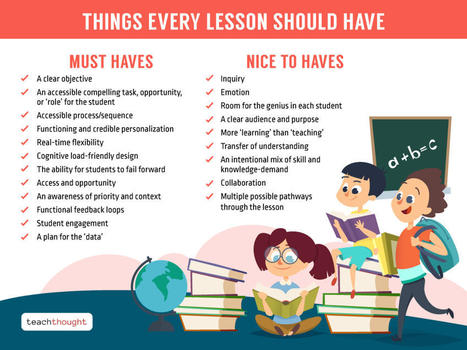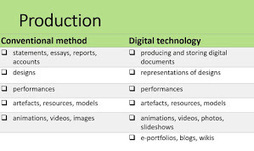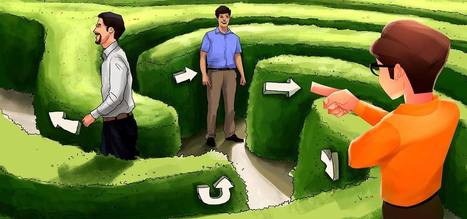During the pandemic, many colleges and universities embraced a form of blended learning called HyFlex, to mixed reviews. Is it likely to be part of colleges’ instructional strategy going forward?This week’s episode of The Key, Inside Higher Ed’s news and analysis podcast, explores HyFlex, in which...
Get Started for FREE
Sign up with Facebook Sign up with X
I don't have a Facebook or a X account

 Your new post is loading... Your new post is loading...
 Your new post is loading... Your new post is loading...
Current selected tag: 'learning design'. Clear
What should every lesson have? Via EDTECH@UTRGV 
EDTECH@UTRGV's curator insight,
June 23, 2021 12:23 PM
Great list! It really provides food for thought on how I'm developing my lessons.
The term "the Prime Directive" harkens back to the days of the TV show "Star Trek." This directive was the binding force that united the federation of planets in a common goal and mission. Can we learn something from this that could give us direction for Instructional Design in the 21st century? Via EDTECH@UTRGV
The Higher Education Digital Capability framework identifies four core dimensions along the learner lifecycle: Demand & Discovery (DD), Learning Design (LD), Learner Experience (LX) and Work & Lifelong Learning (WL). Within these are sixteen capability groups or ‘domains’, with more than 70 capability blocks adding a further level of detail. Overall, the framework is designed to allow flexibility and interpretation in context; some institutions will find almost every capability block relevant to their organisational structure, activities and aspirations, whilst others will focus on a more specific set of capabilities applicable to their individual context.
Transfer is something that is often completely ignored in experience design. But what is the point of having learning experiences of they don’t transfer to actual application and performance? Learning experiences may not only fail to transfer but actually stop transfer.
Dr. Mark Bullen demystifies instructional design by providing a simple and easy to understand explanation of the concept. His key point is that instructional design is all about crafting learning objectives at a level appropriate for the knowledge and skills that are being developed, then
The important role professors play in helping our students appreciate cultural diversity cannot be overvalued. There has been much written about what a Culturally Responsive educator can do to help his or her students engage with the course content, their peers, and their professors in a more meaningful way. In my quest to simplify the process of integrating multicultural content into my classes, I developed a graphic organizer that combines several approaches onto one page. Thus, making it easier for me to select an instructional strategy and set the level of rigor for the learning activity at an appropriate level.
MOOCs, shorthand for massive open online courses, have been widely critiqued for their miniscule completion rates. Industry reports and instructional designers alike typically report that only between 5 to 15 percent of students who start free open online courses end up earning a certificate.
Any time I start work on a new learning project, someone always asks me how I think the learning content should be delivered. Should it be an eLearning course or instructor-led training? Should it be a how-to video or job aid? And while these questions are important to answer, my response is always the same: Why does it have to be one or the other? Why don’t we try designing blended learning?
A term I’ve seen on the increase is that of “Learning Engineer”. Job descriptions using it seem to be pretty similar to a learning technologist, so maybe it’s just this year’s label. Saxberg asks “where are the learning engineers? The sad truth is, we don’t have an equivalent corps of professionals who are applying learning science at our colleges, schools, and other institutions of learning.” I get his point, what is the point of doing all this research into education if we just shrug our shoulders and go “it’s complicated.”
From
padlet
This padlet contains some examples of Technology Enhanced Learning (TEL) tools that span the six types of learning identified by Diana Laurillard (2002). These learning types lie at the heart of UCL's Arena, Blended, Connected (ABC) approach to learning design. Suitable tools are identified under each learning type, which can be used in addition (or as an alternative) to conventional methods of teaching, learning and assessment. Add your own post by clicking on the cross at the bottom of each column. We also welcome comments and questions underneath posts - please share your experience. N.b. scroll down to the bottom of each column to view all posts.
Neuroscience research shows that if you use electrical stimulation whilst teaching your staff, you’ll have better learners. You’ll modulate neuronal activity during training in order to enhance learning and high-level cognitive functions. The science has shown that you can use transcranial electrical stimulation (tES) to apply a small electrical current to the scalp and improve brain function.
As course creators, our highest priorities are to help learners master instructional objectives and transfer new knowledge and skills to real-life situations. At the beginning of a project, course development teams typically create a profile of their target learners. This information might include the number of people taking the class, their job roles, locations, and experience with the subject matter. |
Students often put in a great deal of time and energy into learning course material, yet their efforts are often less than fruitful. Week after week, we witness students arriving to lecture—seemingly prepared—armed with planners, Post-its, highlighters, and tablets. With such obvious effort poured into their preparation, it can be tough to grasp why these same students are often performing poorly on exams.
If there ever was a time to create a flexible structure for student learning and success, the time is now. One of the most empowering and compassionate practices that we can integrate into our classrooms is scaffolding, an instructional strategy that provides students with a framework to guide and support their learning (Wood, Bruner, & Ross, 1976). Scaffolding can offer a weekly structure that supports student growth, creates autonomous learners who are responsible for their own learning, and gives learners more confidence in acquiring new skills.
"UX creation is essential because its purpose is to help learners easily navigate through digital learning modules and classes without getting confused. The learner shouldn’t have to think about the learning process—the learning material should guide them through the module or class. But this is easier said than done. These days, digital learning classes are no longer simple slide decks, but fully-fledged learning experiences consisting of interactive videos, gamified activities, links to learning portals, simulations, and whatnot. This is why there are five basic points every instructional designer should keep in mind when designing modern digital learning classes." Via EDTECH@UTRGV 
EDTECH@UTRGV's curator insight,
December 8, 2020 10:15 AM
Not only is UX design important for creating an uncomplicated and pleasurable learning experience, effective UX design can also help to set the tone for the eLearning experience. First impressions are important and a sloppy user interface can leave a bad taste with learners that may extend throughout the learning experience. What does your UX design say about you?
"UNESCO coined the term ‘OER‘ back in 2002 to describe an initiative intended to bring about educational resources that were universally accessible. Open Educational Resources are described as ‘learning, teaching, and research materials in any media, digital or otherwise, that belong to the public domain, or have been released under an open license permitting free access, use, and adaptation, as well as redistribution by others without restriction.’" Via EDTECH@UTRGV
In response to the worldwide spread of COVID-19, most erstwhile face-to-face and hybrid courses have now transitioned into remotely delivered ones. In these new educational spaces, designing for student success poses some specific challenges, especially because many faculty have had to plan and design to teach remotely at relatively short notice. While instructional designers and technologists are doing their best to help faculty transition to remote teaching during this challenging time, there appears to be relatively little discussion about designing courses for maximizing student success. During these times (perhaps especially now), we need to intentionally design for student success, leveraging tools and pedagogical strategies to support the success of all—especially struggling students.
This article covers the basics of Instructional Design that should be considered when designing content. Download the eBook: Instructional Design 101. Via EDTECH@UTRGV
"Learning theories were created as a basis to explain, describe, analyze and predict how learning should take place. It is important for eLearning professionals to understand how learning takes place because they are in the business of helping people learn. This is what this article discusses." Via EDTECH@UTRGV 
Jorge Jaramillo's curator insight,
August 29, 2019 8:14 AM
Las teorías de aprendizaje han sustentado desde hace muchos años, todas las tendencias educativas que han venido surgiendo y por esto, es necesario tener en cuenta sus principios y lineamientos, para el correcto diseño de productos orientados a facilitar el acceso al conocimiento. En este documento se presenta de una manera muy concreta, el sustento que cada una de estas teorías propone.
Matt Schatt's curator insight,
October 16, 2019 8:18 AM
While this article may seem like a trip back to Educational Psychology 101, its bearing on eLearning and design are indisputable. Much of what is learned in traditional classrooms can be viewed as behaviorist learning with only a few activities finding their way into constructivist and active learning domains. Online learning, however, has the potential to unlock a variety of more student-centered practices to engage and motivate students.
Enhance your eLearning course with the right colors! Read this article now to learn the impact certain colors can have on your learners and gain tips for success eLearning design.
Be part of the eLearning inclusion revolution.
Where did it all go wrong? Professor Elavor* just wrapped up what she hoped would be a successful semester of her new online course—Introduction to Natural Sciences. Unfortunately, the course ended with a giant thud.
The latest in the seminars that I’m coordinating at the Open University was held recently. I was delighted that this one was presented by my colleague Rebecca Galley, talking about 10 Years of Learning Design at the OU. I was part of this project, building on the excellent work of Grainne Conole. Learning Design is a good example of how you implement institutional change in higher education. The project developed tools, worked with ‘friendly’ course teams, became integrated into the formal course approval process, developed standard workshop and support, refined practice, and then adapted to particular needs, eg using LD to focus on retention. |































